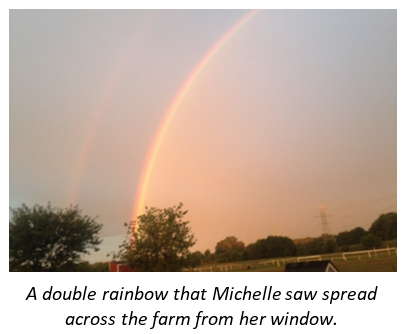
- SAP Community
- Products and Technology
- Technology
- Technology Blogs by SAP
- SAP Champion Spotlight Interview: Michelle Crapo
Technology Blogs by SAP
Learn how to extend and personalize SAP applications. Follow the SAP technology blog for insights into SAP BTP, ABAP, SAP Analytics Cloud, SAP HANA, and more.
Turn on suggestions
Auto-suggest helps you quickly narrow down your search results by suggesting possible matches as you type.
Showing results for
Community Advocate
Options
- Subscribe to RSS Feed
- Mark as New
- Mark as Read
- Bookmark
- Subscribe
- Printer Friendly Page
- Report Inappropriate Content
07-12-2022
6:36 PM
| The SAP Community Spotlight Interview Series highlights key strategic topics, such as emerging technologies, learning, and other topics, and provides insights from industry experts and leaders on turning ideas into innovative approaches that impact people, process, and technology. |
What does reducing stress and finding a level of calmness have to do with digital transformation?
At face value, not much. But there are good reasons to practice wellness, participate in activities outside of work, and find ways thrive in a connected world.
Given the new realities of the work environment (e.g., hybrid and virtual), and the number of business and technology challenges, it is important to prepare mentally and learn to approach new situations with an open mind.

When projects or activities appear complex, too BIG or daunting, then breaking them down into smaller steps, as well as assessing what knowledge needs to be acquired, helps deal with rapid change and ever-growing expectations.
For c436ae948d684935a91fce8b976e5aa7, SAP Champion (& former SAP Mentor), SAP Developer at Furst-McNess, who is a huge animal lover, finding ways to de-stress, continuously learn, and make positive contributions is second nature.
It was fun to connect with Michelle very close to the Great Lakes of Michigan!
Stacey Fish (SF): Hi Michelle! When you were at Western Michigan University (WMU) Haworth College of Business, did you ever think it would lead you to a “Techno-Functional” career with SAP technology? What sparked your interest in SAP ABAP Development and related tools and applications?
 Michelle Crapo (MC): Short answer, NO! I was envisioning myself typing out code in a little room with other programmers, having fun and challenging each other to do better. All of us would love what we did, be happy to learn new things, and use what we learned. That didn’t happen…
Michelle Crapo (MC): Short answer, NO! I was envisioning myself typing out code in a little room with other programmers, having fun and challenging each other to do better. All of us would love what we did, be happy to learn new things, and use what we learned. That didn’t happen…I bounced around a bit and joined a company, that a year later started installing SAP. It was a something I needed to learn quick because ABAP tools were a priority. Then I decided to move towards functional programing and liked that too. I finally found a job that lets me do both.
Why I love tools and apps? Easy, they change a lot. You can never know it all. You can always learn more.
SF: You were part of the WMU Equestrian Team and have continued with your love of animals including: 2 horses, 2 mini-horses, 1 pony, 2 dogs and 3 cats. Given the rapid pace of change with projects (e.g., upgrades to SAP S/4HANA), how does spending time with them bring about a level of calm, balance, and peace?
MC: If you don’t have something you enjoy outside work…I don’t want to say it, but you are going to drive yourself crazy. I learned that a long time ago!
I do enjoy nature. It’s so quiet when I go for a leisure ride on my horse. The sense of being the only one in the world when you are deep in the woods. Or being by the open lake that no one has ever been on. I miss that. How about putting your son on his first horse! Lovely. I miss it. All of my horses are retired. And after one too many falls, I’m retired too. So, I pet them and take them out for some grass – which there is plenty in their field.

The indoor pets are huge stress relievers. They are my best audiences. I work from home. When I’m getting a bit stressed, I quickly find a dog on my feet. You might even catch a cat on my shoulder. I don’t turn on my camera very often…
They make me leave my house. The dogs demand walk time. I enjoy nature. They enjoy, well everything!
Fun Fact: I am allergic to dogs and cats, not horses, but also hay and leaves. Yes, I know…basically the whole great outdoors.
SF: How did you become an SAP Champion (and SAP Mentor Alumni)? In this role, how do you engage with Community members?
MC: This one is strange and an easy question for me to answer. I simply re-connected back into the SAP Community. I went away for a while. A long while... It was too hard for me to read the critical answers. So, it got to the point where I didn’t want to post anything. BUT it is addictive, and I came back because I have a love of learning.
It was right after I came back to the Community when the SAP Champions program was starting up. The initiative was a new way to look at things, to talk or read about other members, and what they really liked/didn’t like about the Community. With this feedback and perspective find ways to help. I wanted to contribute in this way. So, they asked me join, and I said yes!
SF: As someone who loves to learn, you share in your blog, “Learning Block, New Things, and the Boomerang” that “change is constant” and “knowledge is power,” BUT it can all be overwhelming. Whether it be learning open source, like Kubernetes, in an SAP Business Technology Platform (BTP) environment, or something else. Have you come up with a few tips on how to dial back learning anxiety?
MC: For example, I’m having a hard time learning about low/no code (LCNC). When it gets too overwhelming, I try to sit back and approach what I want to learn about like a project.
 The end goal is to either use what is learned in a project or find an alternative approach.
The end goal is to either use what is learned in a project or find an alternative approach.Here’s my steps more or less:
- The Why - First, I put together a scope and validation on why to learn about a certain topic.
- It’s usually not only about work. It might represent something I can use in the future.
- Project List - Next it is helpful to put together a project list and be able to make use of the learning quickly.
- List what you need to do along the way
- Start to fill in the amount of time for each task.
- Identify the end-to-end timeline. Not dates, just hours. (Days or weeks)
- Make assumptions, list them. Perhaps there is a free training class.
- Resources - You need to identify resources.
- What needs to load on your computer?
- Do you have enough processing ability to do it?
- Do you need a book which provides guidance / best practices?
- Assess if an existing or new mentor / colleague has the expertise?
- Constraints - Finally, list the constraints. Mine is always time. Another constraint could be too much data. When that comes up, I go to reliable sources first to gain perspective.
Now, you can put a check by each of the steps and assess what you know, what needs to be learned, and the best approach to acquiring the knowledge required. These steps make it easier to take it in small bites. Then you can pick it back up later when there is time.
BTW – My first check mark is just “creating the plan.” I know I’ll never forget that one!

SF: Gaining SAP ABAP and other programming work experiences can be challenging. What advice do you give students and recent alumni who want to get developer-related jobs in the SAP Ecosystem and beyond?
MC: Internships (either paid or unpaid) are a huge plus. Look at the jobs that are open in your area.
What are they looking for? Is it newer skill sets or older ones? Try to acquire what you need to be successfully in your field of choice. A fun way to get recognition is the SAP Community Code challenges.
Be aware that even if they don’t say it, most jobs require good communication skills. You could be writing tests, requirements, technical requirements, scope and many more documents. Be ready for technical and communication questions.
--------------------------------------------------------------------------------------------------------------------------------------
Michelle and I would like to hear from you:
- What are your tips to reduce stress and anxiety?
- How do you manage projects or activities that are complex?
- What are your tips, tricks or steps when learning something new?
- SAP Managed Tags:
- ABAP Connectivity,
- ABAP Development,
- ABAP Extensibility,
- SAP Community,
- SAP Business Technology Platform
Labels:
1 Comment
You must be a registered user to add a comment. If you've already registered, sign in. Otherwise, register and sign in.
Labels in this area
-
ABAP CDS Views - CDC (Change Data Capture)
2 -
AI
1 -
Analyze Workload Data
1 -
BTP
1 -
Business and IT Integration
2 -
Business application stu
1 -
Business Technology Platform
1 -
Business Trends
1,661 -
Business Trends
87 -
CAP
1 -
cf
1 -
Cloud Foundry
1 -
Confluent
1 -
Customer COE Basics and Fundamentals
1 -
Customer COE Latest and Greatest
3 -
Customer Data Browser app
1 -
Data Analysis Tool
1 -
data migration
1 -
data transfer
1 -
Datasphere
2 -
Event Information
1,400 -
Event Information
64 -
Expert
1 -
Expert Insights
178 -
Expert Insights
273 -
General
1 -
Google cloud
1 -
Google Next'24
1 -
Kafka
1 -
Life at SAP
784 -
Life at SAP
11 -
Migrate your Data App
1 -
MTA
1 -
Network Performance Analysis
1 -
NodeJS
1 -
PDF
1 -
POC
1 -
Product Updates
4,578 -
Product Updates
323 -
Replication Flow
1 -
RisewithSAP
1 -
SAP BTP
1 -
SAP BTP Cloud Foundry
1 -
SAP Cloud ALM
1 -
SAP Cloud Application Programming Model
1 -
SAP Datasphere
2 -
SAP S4HANA Cloud
1 -
SAP S4HANA Migration Cockpit
1 -
Technology Updates
6,886 -
Technology Updates
397 -
Workload Fluctuations
1
Related Content
- No-Code Guide: SAP S/4HANA Cloud to SAP Build Apps Data Visibility in Technology Blogs by Members
- Spotlight Month - Thank You For Your Community Contributions in Technology Blogs by SAP
- Spotlight Interview with SAP Champion – Priyanka Chakraborti in Technology Blogs by SAP
- Why Join SAP's Industry Cloud for Mid-market? An interview with channel partner ConvergentIS in Technology Blogs by SAP
- Dedication and Contribution Pave the Way to Success / SAP Champion Spotlight with Lakshmipathi Ganesan in Technology Blogs by SAP
Top kudoed authors
| User | Count |
|---|---|
| 11 | |
| 11 | |
| 10 | |
| 9 | |
| 7 | |
| 7 | |
| 7 | |
| 7 | |
| 6 | |
| 5 |